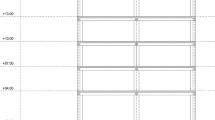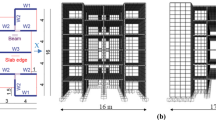Abstract
The seismic performance of a structure with hysteretic energy dissipation devices (HEDDs) is significantly influenced by their cyclic structural characteristics. This is due to the fact that the acceleration and displacement responses of the structure mainly depend on the dissipating capacities of HEDDs. Hence, it is important to verify the cyclic characteristics of the HEDDs in designing the structure. Recognizing this importance, a current ASCE/SEI 7 requires prototype tests of energy dissipating systems that consist of HEDDs and their connecting components with a seismic-force-resisting system. The codified requirements for the prototype tests prescribe the acceptance criteria of energy dissipating systems, so called as a 15 percent rule. However, there is little information on the reliability of such acceptance criteria. As a part of research efforts to figure out this problem, this paper carries out sensitivity analysis of the seismic responses of steel moment-resisting frames influenced by the cyclic characteristics of damping systems employing HEDDs. Throughout the sensitivity analyses using probabilistic approaches, this study numerically assesses the influence of HEDD’s cyclic characteristics on the seismic response of steel moment-resisting frames. The analysis results show that the change of HEDD’s design parameters significantly affects the seismic response and of the HEDD’s design parameters, the initial stiffness and yield strength are the most influential parameters. Furthermore, the variation of the important structural engineering parameters is similar to or smaller than 10% of their mean values if all design parameters of HEDDs are satisfied with the prototype testing requirements prescribed in ASCE/SEI 7.
Similar content being viewed by others
References
ASCE/SEI 7 (2010). Minimum design loads for buildings and other structures. American Society of Civil Engineers, Virginia, USA.
Carr, A. J. (1998). User’s manual of RUAUMOKO, the Maori god of Volcanoes and earthquakes. Department of Civil Engineering, University of Canterbury, New Zealand.
Chopra, A. K. (2012). Dynamics of Structures: Theory and Applications to Earthquake Engineering, 4th Ed., Prentice Hall, Englewood Cliffs, New Jersey, USA.
Chryssanthopoulos, M. K., Dymiotis, C., and Kappos, A. J. (2000). “Probabilistic evaluation of behavior factors in EC8-designed R/C frames.” Engineering Structures, 22(8), pp. 1028–1041.
Enrico, Z. (2013). The Monte Carlo Simulation Method for System Reliability and Risk Analysis. Springer, London, UK.
FEMA-356 (2000). Pre-standard and commentary for the seismic rehabilitation of buildings. Federal Emergency Management Agency, Washington D.C., USA.
FEMA-P695 (2009). Quantification of building seismic performance factors. Federal Emergency Management Agency, Washington D.C., USA.
Frangopol, D. M., Ide, Y., Spacone, E., and Iwaki, I. (1996). “A new look at reliability of reinforced concrete columns.” Structural Safety, 18(2), pp. 123–150.
Ghobarah, A. and Aly, N. M. (1998). “Seismic reliability assessment of existing reinforced concrete buildings.” Journal of Earthquake Engineering, 2(4), pp. 569–592.
Hanson, R. D., Xia, C., and Su, Y. F. (1992). “Design of supplemental steel damping devices for building.” Proc. Tenth World Conference Earthquake Engineering, Rotterdam
Kim, J. R., Park, J. H., and Lee, T. H. (2011). “Sensitivity analysis of steel buildings subjected to column loss.” Engineering Structure, 33(2), pp. 421–432.
Lee, T. H. and Mosalam, K. M. (2006). Probabilistic seismic evaluation of reinforced concrete structural components and systems. PEER Technical Report, Pacific Earthquake Engineering Research Center, University of California, Berkeley, USA.
Lee, T. H. and Mosalam, K. M. (2009). “Identifying significant components of structures for seismic performance using FOSM method.” Journal of Earthquake Engineering Society of Korea, 13(4), pp. 37–45.
Otani, S. (1981). “Hysteresis models of reinforced concrete for earthquake response analysis.” Journal of Faculty of Engineering, 36(2), pp. 125–159.
Oviedo, J. A., Midorikawa, M., and Asari, T. (2010). “Earthquake response of ten-story-drift-controlled reinforced concrete frames with hysteretic dampers.” Engineering Structures, 32, pp. 1735–1746.
Porter, K. A., Beck, J. L., and Shaikhutdinov, R. V. (2002). “Sensitivity of building loss estimates to major uncertain variables.” Earthquake Spectra, 18(4), pp. 719–743.
Powell, G. H. and Allahabadi, R. (1988). “Seismic damage prediction by deterministic methods: Concepts and procedures.” Earthquake Engineering and Structural Dynamics, 16(5), pp. 719–734.
Ramirez, O. M., Constantinou, M. C., Kircher, C. A., Whittaker, A. S., Johnson, M. W., Gomez, J. D., and Chrysostomou, C. Z. (2000). Development and evaluation of simplified procedures for analysis and design of buildings with passive energy dissipation systems. Report No. MCEER 00-0010, Revision 1, Multidisciplinary Center for Earthquake Engineering Research, University at Buffalo, State University of New York, Buffalo, N.Y., USA.
Reiter, L. (1990). Earthquake Hazard Analysis. Columbia University Press, New York, pp. 254.
Shinghal, A. and Kiremidjian, A. (1996). “Method for probabilistic evaluation of seismic structural damage.” Journal of Structure Engineering, ASCE, 122(12), pp. 1459–1467.
Shinozuka, M. (1972). “Probabilistic modeling of concrete structure.” Journal of Engineering Mechanics Division, ASCE, 98(6), pp. 1433–1451.
Tsai, K. C., Cheng, H. W., Hong, C. P., and Su, Y. F. (1993). “Design of steel triangular plate energy absorbers for seismic-resistant construction.” Earthquake Spectra, 9(3), pp. 505–528.
Xia, C. and Hanson, R. D. (1992). “Influence of ADAS element parameters on building seismic response.” Journal of Structural Engineering, 118(7), pp. 1903–1918.
Author information
Authors and Affiliations
Corresponding author
Additional information
Discussion open until May 1, 2015. This manuscript for this paper was submitted for review and possible publication on February 24, 2014; approved on December 1, 2014.
Rights and permissions
About this article
Cite this article
Shin, DH., Kim, HJ. Probabilistic assessment of structural seismic performance influenced by the characteristics of hysteretic energy dissipating devices. Int J Steel Struct 14, 697–710 (2014). https://doi.org/10.1007/s13296-014-1202-2
Published:
Issue Date:
DOI: https://doi.org/10.1007/s13296-014-1202-2




